



|
A “Craftsman” is a skilled worker who practices or is highly skilled in a craft and makes things or provides services. They have shown finely honed creative skill applied toward something of utility, whether it be a plate of food or a piece of furniture. This differentiates it from artistry (which is creative but may not have a practical use) and workmanship (which demonstrates skill but may be merely practical). Craftsman is an Information Management application that assists businesses that provide services to their customers by repairing, modifying or servicing customer owned items. These businesses can include businesses that repair electrical, furniture, clothing goods; they can include businesses that modify items, like clothing; and can include businesses that service items like laundries and dry-cleaners, just to name a few. |
|
|
|
|
|
So what does Craftsman do? |
|
 |
Craftsman manages your customer records. It provides a full set of Accounting facilities. It provides Service Management facilities including purchasing, service delivery, stock and inventory management, and Sales. It manages your work tasks. It records your payroll expenses. It provides Call Centre Management facilities. It manages vehicle usage and expenses. It manages the organisation’s employee details records. It assists the preparation of shift staff allocation by defining shift and providing facility to allocate staff to the various roles in a shift. It provides full support for the management of assets and prints asset labels which include a barcode. It provides Equipment Maintenance facilities. It provides support for the management of staff expenses. It allows for the recording of timesheets which can then be submitted to the employee’s manager for review and approval. It allows managers to review and approve/reject timesheets or individual entries. Craftsman maintains units of measurement (UOM), types of leave and public holidays that are used by the rest of the application. |
|
Craftsman maintains your employee’s details including their personal details, manager, next of kin, a photo, email address and network user id, employment details, remuneration details. It stores any documents, like resumes as attachments. It can record the different positions the employee has held with the organisation; any payroll additional allowances or any deductions applicable to the employee; the banking details to use by payroll for the employee; the superannuation, if applicable, account(s) details to use by payroll for the employee; and general notes. You can save a photo of the employee and generate a unique id for that employee. The barcode generated used the common Code 39 barcode type used for various labels such as name badges, inventory and industrial applications. The symbology of the Code 39 character set consists of barcode symbols representing numbers 0-9, upper-case letters A-Z, the space character and the following symbols: – . $ / + %. Lower-case characters may also be used. The photo and barcode will appear on the employee’s ID card when produced. It can generate an employees address book and phone list. |
 |
 |
Craftsman maintains your customer’s details including their personal details, a photo, email address and mailing address. It stores any documents relating to the customer. Craftsman maintains a list of orders the customer has made. |
|
Craftsman provides accounting/financial report to support the financial administration of the organisation. Most of these reports can be viewed on an enquiry screen, generated as a PDF or printed out. These reports include:
Obviously, these reports are generated using the expenses and income data recorded throughout the application, which is recorded using classes and categories to support the financial reporting. |
 |
 |
Craftsman maintains a list of services provided. It also maintains a list, per service, of tasks that can be performed. These lists represent the pricing list that is used when quoting and invoicing orders. |
|
Craftsman supports the materials inventory process by defining items the organisation has available for repair replacements. Craftsman also support inventory items are are company assets or equipment and need to be uniquely identified by a serial number. A unique serial number is generated using the product category. Craftsman allows for item delivered by the vendor damaged or unusable, to be return back to the vendor for a refund. It also allows for spoilt, damaged or unusable items in the inventory to be disposed at a loss. |
 |
 |
Craftsman supports the purchasing process for materials, and warehousing, to support the servicing process. It can maintain warehouses of available items and manage re-stocking. It maintains a list of suppliers and the items they supply. It can issue purchasing orders and maintains an inventory of these. As items are either equipment, assets or parts/replacements used in the servicing process, it updates the inventory so that the current available stock of any item is known. You can view at any time the purchase transactions and inventory transactions. Craftsman can print a report which items require re-ordering to maintain the stock levels preferred. It can produce many reports that assist in analysing the inventory. It can also print a Suppliers Directory listing every supplier and the items they provide; this can be used as an easy reference when ordering new stock. |
|
Craftsman support the organisation's sales activities by recording customer orders and then following through to an actual delivery and payment. Craftsman can store documents and scan documents. It can also take photos relating to the customer's order and/or items supplied; this can assist in comparing the state of the item(s) supplied before and after servicing. Craftsman allocates unique identifiers to items supplied by customers and then generates barcodes which will appear in dockets or labels that can be attached to the item(s) for easy tracking. These bardcode can then be scanned and the customer order identified, which assists in tracing the owners of items located in the organisation's care. Craftsman can produce customer fully itemised invoices. In order to support the whole purchasing -> servicing -> invoicing, Craftsman produces various reports reporting on various aspects of the stocking process. |
 |
 |
Craftsman support the generation of shift resourcing plans. Shifts and the different roles/jobs within these shifts can be defined. Craftsman reviews each resourcing selection to ensure that a staff member has no overlapping shift. It also ensures that a staff member is not allocated to shifts without a normal shift gap in between, i.e. no 2 shifts in a row, in order to manage staff fatigue. |
|
Craftsman can allocate outstanding work tasks the staff, as per the shift plan. These tasks could be as a result of a customer orders. Staff is allocated based on the role identified in the task and the staff member. When allocating tasks, care is taken not to exceed the maximum work time per shift. |
|
 |
Craftsman can track the progress of work on outstanding tasks. These tasks are generated at the time a customer order is lodged; they have been identified based on the services the customer has requested per item supplied. Time worked is calculated based on staff timesheets; spare parts or other items supplied in order to completed the task, are also tracked. These will be added to the customer's final invoice. Craftsman can store documents and scan documents relating to the execution of these tasks. It can also take photos which can assist in comparing the state of the item(s) supplied before and after servicing. It provides multiple reports to support monitoring and managing of these tasks. |
|
Craftsman provides facilities for asset management. It can define asset types and location where these assets are kept. It can register assets, including a description, photo, manufacturer, model, serial number and store any documents, like brochures. It can generate identifying barcodes and print asset label which are then attached to the assets. It can allocate assets to staff and monitor their return when the staff member terminates their employment with the organisation. It provides multiple reports to support monitoring and managing of these assets. |
 |
 |
Craftsman provides facilities to support task management. These tasks are work tasks defined by by customer orders and the services requested. These tasks are then available for staff in the timesheet recording facility. Various reports are also provided to manage these tasks. |
|
Craftsman allows staff to make claims for refunds of working expenses. These claims can take one of two forms: mileage claims for travel or cash expenses; for cash expenses the staff member can attach supporting documentation, including receipts and invoices. Craftsman supports the scanning of these attachment through a TWAIN compliant scanner. The staff member submits the claim and it's then sent to their manager for review and approval. It provides multiple reports to support monitoring and managing of these claims. |
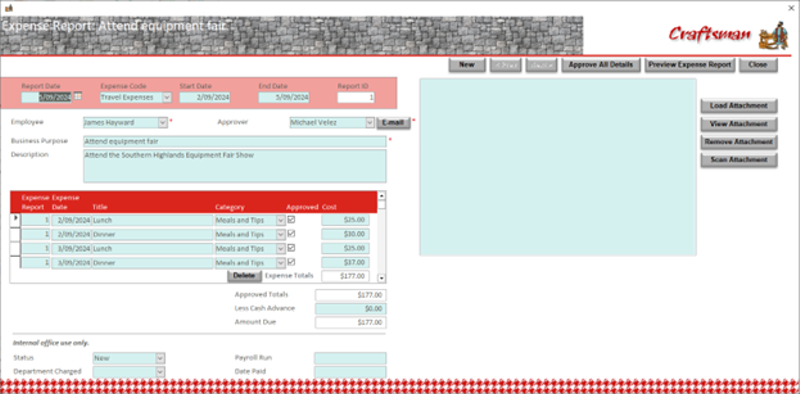 |
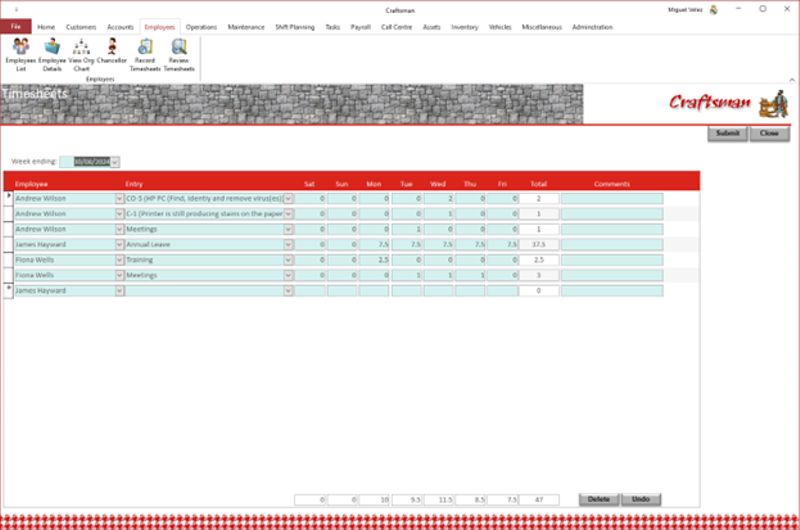 |
Craftsman can record an employee's timesheet and it can be submitted for review and approval. Time recorded against outstanding tasks are
then added to the tasks' actual hours work and may be used during the billing process.
Craftsman provides 2 options for timesheet recording:
The timesheet data is then used, along with the employees' salary package information, to calculate payroll costs and update the organisation's balance sheet. |
|
Craftsman, as mentioned above, uses the timesheet data recorded, and approved, by staff to calculate payroll costs. It also uses the staff's salary package information to calculate payroll costs. These costs are then added to the balance sheet so that a full picture of the financial state of the organisation can be viewed. Craftsman can also import a payroll expenses report from your payroll solution; for that purpose a sample layout Excel (.xls) file is included so that the format of this file can be identified.
|
 |
 |
Craftsman, as already mentioned, supports the operation of stores and warehouses within the organisation. It can maintain stores of available items and manage re-stocking. It maintains a list of suppliers and the items they supply. It can issue purchasing orders and maintains an inventory of these. It can receive requests for items and fill them and update the inventory so that the current available stock of any item is known. You can view at any time the purchase transactions and inventory transactions. Craftsman can print a report which items require re-ordering to maintain the stock levels preferred. It can produce many reports that assist in analysing the inventory. It can also print a Suppliers Directory listing every supplier and the items they provide; this can be used as an easy reference when ordering new stock. |
|
Craftsman also provides call centre facilities. Calls from customer with issues or queries can be logged and assigned to individual staff the address. If multiple calls are made relating to the same issue, these can be linked. The response to these calls can be recorded and information emailed to the caller. These calls can result on additional work performed and additional stock items used. These are then recorded against the call/case. Craftsman maintains a knowledge base of known responses so that they can easily be referenced and the issue resolved quicker. |
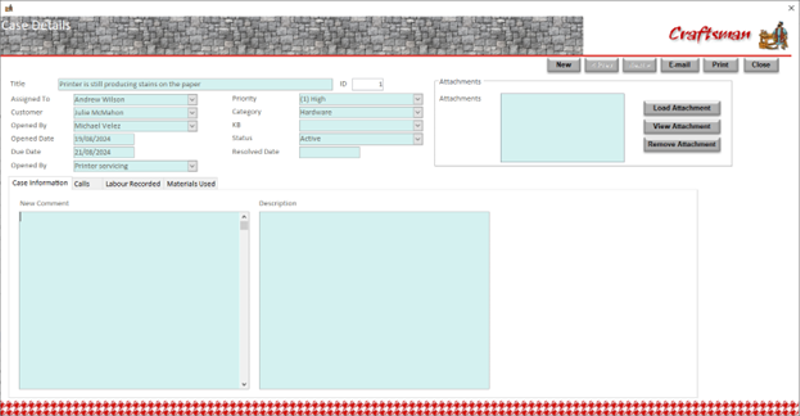 |
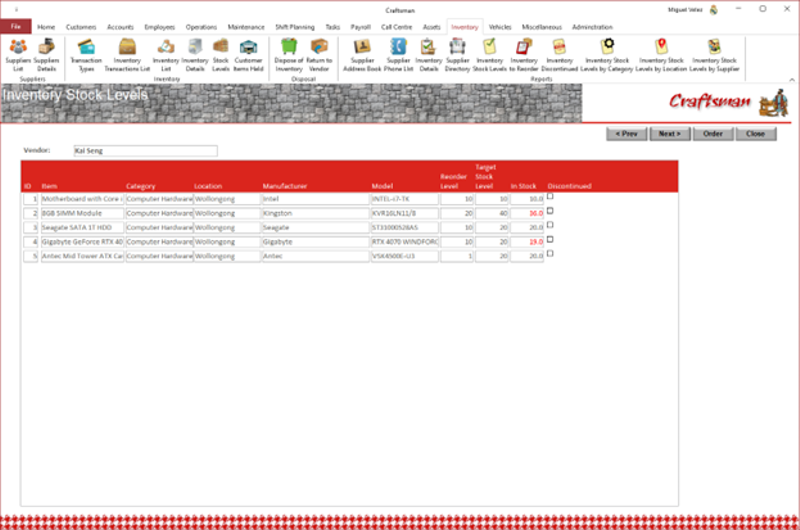 |
Craftsman monitors stock levels and can initiate the re-ordering purchasing order semi-automatically. It will enquire to identify those stock items below the desired level and generate purchase orders for them which can be reviewed and modified by the user, if required. |
|
Craftsman supports fleet or vehicle management. It can record details of the vehicles managed by the organisation. It can also record details of authorised staff owned vehicles that can be used for business purposes. Craftsman can records trips undertaken by staff in these vehicles for business purposes and then process refunding of costs to staff. These costs are also added to the organisation's balance sheet. |
 |
 |
As mentioned earlier, Craftsman can manage assets; some of these assets would be identified as equipment. In such cases, Craftsman can also record maintenance inspections cycle details, which would then be monitored. These cycles can be expressed in days, weeks, months or years. |
|
Craftsman will monitor the defined inspections cycles per equipment item and identify when inspections are due. Inspection can then be initiated. You can also initiate an inspection even when it's not due, if you deem it necessary. When an inspection is performed, Craftsman can record the results of the inspection. If the inspection has failed, Craftsman will then initiate a repair task; the equipment item will be marked unavailable. If the inspection passes, Craftsman will then determine when the next inspection is due, based on the inspection cycle defined. |
 |
 |
Craftsman can allocate outstanding repair tasks the staff, as per the shift plan. These tasks could be as a result of failed maintenance inspections. Staff are allocated based on the role identified in the task and the staff member. When allocating tasks, care is taken not to exceed the maximum work time per shift. |
|
Craftsman can track the progress of work on outstanding repair tasks. These tasks are generated due to failed inspections of equipment. Time worked is calculated based on staff timesheets; spare parts or other items supplied in order to completed the task, are also tracked. Once work has been completed on an item's repair task(s), Craftsman submits it for re-inspection or testing. If the item now passes inspection, it's marked available and returned to operations. |
 |
 |
Craftsman provides inbuilt Emailing facilities. Emails can be imported from your Email Server without the need for an Email client like Microsoft Outlook. These Emails are then stored within the database along with any attached documents. Emails can be printed. |
|
Craftsman can also send Emails through your Email Server without the need for an Email client like Microsoft Outlook. These Emails are then stored within the database. |
 |
 |
The Craftsman package includes Messenger, our Instant Messaging tool. This tool can be distributed to all employees no matter the licenses of Craftsman have been purchased. It’s use to communicate with each other in a fast and simple manner. And what's more important, this application is free; purchase licenses for the use to the full Craftsman application and then you can distributed this application to all other staff members. |
|
The Craftsman package includes Employee Portal. This tool provides access to some of the functionality of some of our other business information management application. May be not all you employees need access to the business process(es) functionality of these applications, but need the ability to record their timesheets and lodge expenses claims. Employee Portal provides this functionality. And what's more important, this application is free; purchase licenses for the use to the full Craftsman application and then you can distributed this application to all other staff members. |
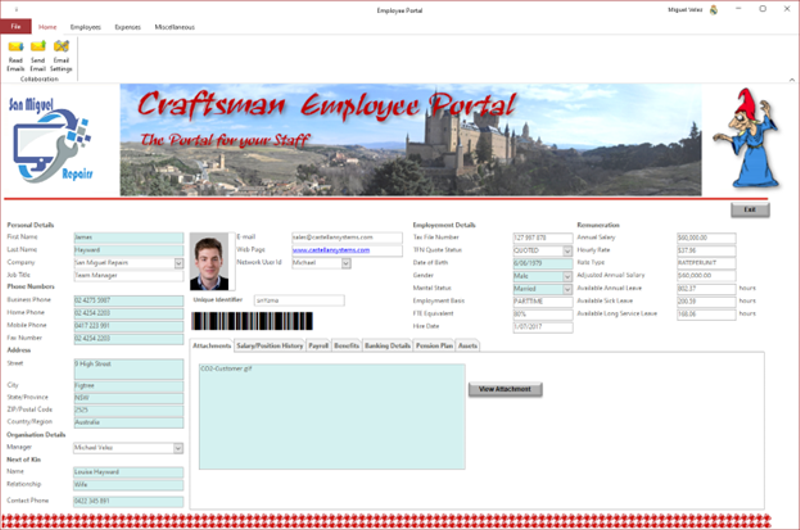 |
|
Please Note: You only have to purchase Craftsman licenses for staff engaged in business processes covered by the application. You can then distribute the Messenger application to all other staff members and allows then to instantly communicated with each other. |
|


